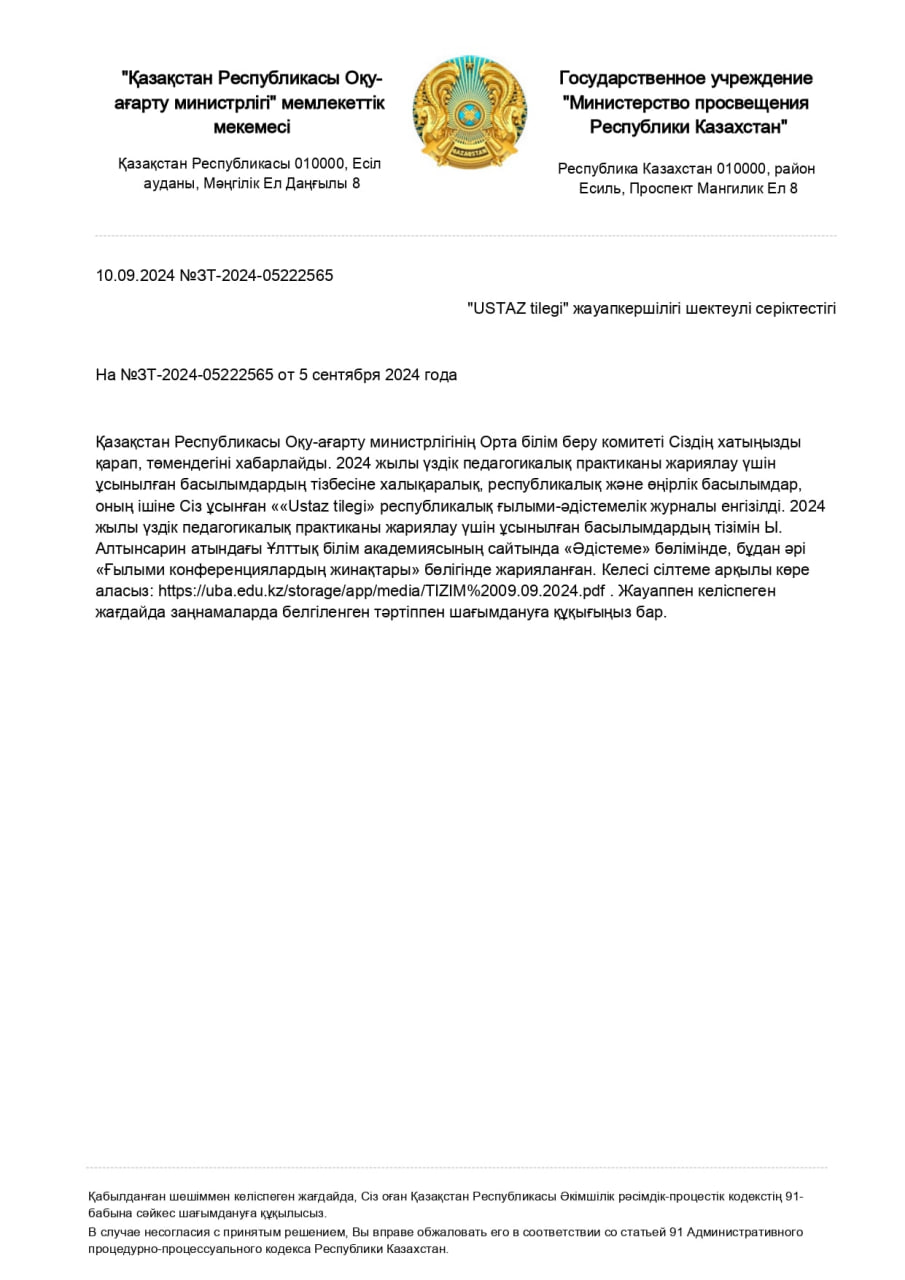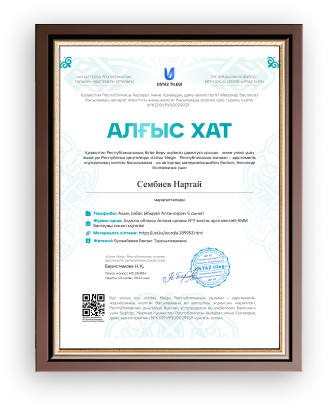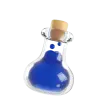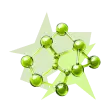
|
Content |
|
|
Introduction……………………………………………………………… |
3 |
|
1. Inorganic synthesis................................................................................. |
4 |
2. Extraction of inorganic compounds....................................................... |
6 |
|
3. Safety precautions when performing work on inorganic synthesis........ |
9 |
|
Conclusion.................................................................................................. |
10 |
|
References................................................................................................... |
11 |
Introduction
Unlike other natural sciences, chemistry itself creates the objects of its research. Gone are the days when scientists studied mainly substances that exist in a ready-made form. Of the several million chemical compounds now known, only a relatively small part are those that existed before the appearance of man. The share of minerals in the whole set of inorganic compounds is continuously falling, because the number of natural minerals is constant, and the total number of inorganic substances is growing by several thousand annually. The preparation of substances began in the heyday of alchemy (XII-XII centuries – ammonia, nitric, sulfuric, hydrochloric acids). Only after Lavoisier (XVIII century) did the synthesis of inorganic compounds become a process with predictable results.Synthesis (Greek. synthesis) connection, combination, construction. In relation to chemistry, synthesis is any set of sequential actions leading to the production of the desired chemical substance. Inorganic synthesis in modern chemistry is engaged in the search for ways to obtain and identify new inorganic compounds, as well as the creation of new methods for obtaining known compounds. The solution of almost every new technical problem requires the search for materials or chemicals with a given set of properties. This is one of the central tasks of chemistry, which is solved by the directed synthesis of the corresponding compounds. The difficulty lies in the fact that the relationship between the composition and structure of the compound and its physical properties is not sufficiently predictable theoretically. Therefore, all the main tasks of synthetic chemistry are solved empirically (experimentally).
Which of the many conceivable structures constructed from atoms will have sufficient kinetic stability to exist stably under given conditions? The problem of existence belongs rather to the field of quantum mechanics. Synthetic chemists have to choose from a variety of structures that are more or less similar to those already known. It is impossible to predict fundamentally new compounds, just as it is impossible to state the content of a discovery that has not yet been made. But the analogy method also often gives errors. Methods of inorganic synthesis are a set of techniques that lead to the creation of a given structure, a given order of arrangement of atoms in a molecule, a given method of connecting finished fragments into a complex molecule or lattice. The difficulty of solving this problem is due to the fact that the synthesis method developed for one particular object is often unsuitable for solving another, externally similar task. To construct a new complex molecule, it is necessary to find new techniques.
1. Inorganic synthesis
Inorganic synthesis is the process of obtaining inorganic compounds. As a rule, it consists of several sequential or parallel processes - mechanical, chemical, physico-chemical. In general, inorganic synthesis includes mixing of reagents, activation of the reaction mixture and the actual chemical reaction, isolation and purification of the target product.The choice of the mixing method is determined by the properties of the reagents and products and their aggregate state. It is most difficult to obtain homogeneous mixtures of substances that differ greatly in properties, especially those in different aggregate states or in the form of powders.
The most common activation methods are an increase in temperature and pressure. At the same time, the speed of the processes increases, and a change in the yield and phase state of the products can also be achieved. An increase in pressure can also lead to a change in the direction of the chemical reaction, a decrease in the rate of chemical reactions in the case of solids, an expansion of the homogeneity of solid phases, stabilization of denser phases (e.g., diamond). In spec. the devices reach a pressure of about 108-109 Pa. Catalysts, electric current, intense light radiation, ionizing and microwave radiation, magnetic fields, ultrasound, powerful beams of charged particles, etc. are also used for activation. Solids are activated by grinding, abrasion, a combination of high pressure with shear, as well as special fur. techniques.
For the synthesis of inorganic compounds, reactions are used - OVR, complexation, decomposition, etc., which can be carried out in gas, liquid, solid phases or in heterogeneous systems. Many syntheses are carried out in aqueous and non-aqueous solutions. In this case, the target component or impurities are transferred to a precipitate (precipitation, crystallization, salting, freezing), a gas phase (distillation), a second liquid phase immiscible with the initial solution (liquid extraction), foam (ion flotation), on the surface or in the volume of a solid sorbent (ion exchange sorption). Substances in microgram quantities are also obtained by co-deposition. Gaseous substances are purified by selective condensation (or desublimation), selective absorption by solutions, melts or granular solids, solids - by recrystallization (in particular, under hydrothermal conditions; zone melting, by chemical transport reactions, etc. Selective oxidation, reduction or complexation is often used for purification. Various types of chromatography, membrane separation processes, distillation, rectification are also used.
The use of vacuum during inorganic synthesis provides greater purity of products, and in the case of thermally unstable substances - a greater yield. Plasma chemistry methods provide for the transfer of reagents using electric discharges, electric arc or high-frequency radiation into a state of low-temperature plasma with the latter. hardening of products. The design and synthesis of organic–inorganic hybrid materials has developed over the last two decades as chemists and materials engineers have maintained their attention on these materials. In the synthetic process of organic–inorganic hybrid materials, the organic components usually act as templates for directing the connectivity and arrangement of inorganic building blocks. Specifically, according to the size and scale of inorganic building blocks, these organic–inorganic hybrid materials can be divided into molecular scale and nanoscale organic–inorganic hybrid materials. In this review, we highlight the recent advances in using small organic molecules as the templates for the synthesis of organic–inorganic hybrid nanomaterials with interesting properties. The synthetic techniques, hybrid crystal structures, templating roles, crystal growth mechanism, control of sizes and morphologies, and novel properties of organic–inorganic hybrid materials will be discussed. The volumes in this continuing series provide a compilation of current techniques and ideas in inorganic synthetic chemistry. Includes inorganic polymer syntheses and preparation of important inorganic solids, syntheses used in the development of pharmacologically active inorganic compounds, small-molecule coordination complexes, and related compounds. Also contains valuable information on transition organometallic compounds including species with metal-metal cluster molecules. All syntheses presented here have been tested.
The synthesis of inorganic compounds embraces an immense range of techniques and approaches. New organometallic molecules, for example, might demand multi-step organic reactions in the successful production of ligands followed by precision handling and manipulation to form the desired complexes under anaerobic conditions. By contrast, preparation of solid state compounds can demand extreme conditions of temperature and pressure to overcome the formidable thermodynamic and kinetic barriers to their formation. It is the target of many inorganic chemists, both by experiment and computation, to prepare or predict new compounds and materials, to discover the most appropriate conditions under which such substances can be made and to design the experiments that will realise them. New inorganic compounds remain attractive, for example, for their inherent complexity and beauty, for their chemical behaviour, their chemical or biological activity or for their physical properties.
The need and desire for new compounds often demands increasingly sophisticated and imaginative synthesis strategies. Equally, the modern societal pressures of cost, safety and environmental protection require new attitudes to the synthesis of high value chemical products. Time and energy efficiency, use of earth-abundant resources and many other green chemistry principles become key parameters in the design of new synthetic processes. I would like to dedicate this inaugural issue of “Inorganics” therefore, to the concept of “innovative synthesis” from the intricacy of constructing extended molecular solids on the basis of weak supramolecular forces through the appealing simplicity of “one-pot” methods to make cluster and hybrid materials and soft chemical means to produce solid state materials to the adaptation of inefficient lab techniques towards streamlined flow processes for the preparation of fine chemicals. This special issue invites contributions in all of the above areas and beyond; the primary requisite being the application of creative approaches to achieve synthetic goals.
2. Extraction of inorganic compounds
Reactive solvent extraction is commonly used in industries to extract organic and inorganic products. In such a process, the solute present in an aqueous solution is extracted into an immiscible solvent containing a specific extracting agent. These experiments are usually carried out in conventional dispersion-based contacting devices such as colunm or mixer-settlers. Under this configuration, two problems arise: the extracting agent (usually a toxic or environmentally harmful compound) is dispersed into the medium and later in the environment and/or permanent emulsions are formed. To overcome these drawbacks, the introduction of a solid membrane between the two fluid phases using a hollow fibre liquidliquid contactor in order to keep a large surface of contact between the two media represents a good alternative. Two selected examples will be shortly presented in this article to illustrate the interest of this technology that uses the same membrane for the extraction of organic and inorganic compounds from aqueous solutions.
Investigation on liquid emulsion membrane (LEM) prepared with hydrodynamic cavitation process for cobalt (II) extraction from wastewater
It is attributed to accomplishment of extraction and stripping processes in a single unit operation leading to cost effective process. Liquid emulsion membrane process showed effective separation of various pollutants like acids/base, phenolic compounds, metal ions, hydrocarbons and inorganic compounds which is attributed to higher mass transfer rates due to higher interfacial area . The main feature of the LEM is the use of organic compound as an extractant or carrier. In the present work, the preparation of liquid emulsion membrane (LEM) considering Aliquat 336 as a carrier was accomplished first time with the use of hydrodynamic cavitation (orifice based) process. The other components/ingredients used for the preparation of LEM were kerosene (diluent), span 80 (emulsifier) and NaOH which was used as a stripping agent in the internal phase. The extraction process of cobalt (II) from wastewater was investigated using the LEM prepared with the orifice plates having diameter equal to 1 mm and 5 mm. Further, the influence of various elected parameters like processing time, orifice diameter, carrier concentration and external feed phase to emulsion membrane phase ratio (i.e. treat ratio) on extraction efficiency of cobalt (II) from the feed phase have been examined and reported. The obtained results confirmed the possibility of 100% extraction of cobalt (II) using hydrodynamically prepared LEM from the aqueous feed phase which contains 100 ppm cobalt (II). The % extraction efficiency of cobalt increases with the carrier concentration and also with LEM prepared in hydrodynamic cavitation for various cavitation time up to certain limit. Further, the concentration of span 80 has been established to be adequate for the stability of the LEM throughout the cobalt (II) extraction process. In the present work, the effectiveness of hydrodynamic cavitation based process for the preparation of stable LEM with an application in the separation of cobalt (II) from the aqueous feed phase has been established.
The recovery of valuable compounds from food wastes and by-products kills two birds with one stone and addresses both the use of by-products and societal health care. Traditional extraction methods include usually high-temperature treatment (more than 100°C) with the subsequent risk of thermal denaturation or transformation of the target molecules. Moreover, these techniques are very time-consuming and require relatively large quantities of solvents. On the other hand, the use of environment-friendly technologies has led researchers and the food industry to develop new alternative processes that can extract valuable compounds from different sources and food wastes of different origins. This chapter describes the potential use of emerging technologies such as ultrasound-assisted extraction, laser ablation, pulsed electric fields, high-voltage electrical discharge, membrane-assisted extraction, and solvent-induced complexation. The latest methodologies comply with the concepts of green chemistry and sustainability.
Traditional extraction methods include usually high temperature treatment (more than 100°C) with the subsequent risk of thermal denaturation or transformation of the target molecules. Moreover, these techniques are very time-consuming and require relatively large quantities of solvents. On the other hand, the use of environmentally friendly technologies has led researchers and the food industry to develop new alternative processes that can extract valuable compounds from different sources and food wastes of different origin. This chapter describes the potential use of emerging technologies such as ultrasound-assisted extraction (UAE), laser ablation, pulsed electric fields (PEF), high voltage electrical discharge (HVED), and membrane-assisted extraction. The latest methodologies comply with the concepts of green chemistry and sustainability within the food industry.
Extraction with membrane contactors is an attractive technological alternative for organic acid separation from fermentation broths. This work aims at studying the recovery process of succinic acid, integrating both extraction and re-extraction steps. It was proposed to use a non-porous membrane, which allows more flexibility of operation without loss of efficiency. For the integrated process, a 5-fold increase in the recovery of acid from the feed stream was observed when compared to the single extraction process, leading to an overall recovery close to 50%. An experimental study of betaine separation involving non-dispersive solvent extraction using hollow fibers is described. The extractant was a solution of dinonylnaphthalene sulfonic acid (DNNSA) in n-heptane and stripping was performed with sodium hydroxide solution. Different operating conditions for the extraction and stripping processes were tested using a single hollow fiber contactor and then both processes were operated simultaneously using two contactors in series. The experimental results were fitted using a kinetic model with two design parameters, namely the overall mass-transfer coefficients referred to the feed and stripping phases. The overall coefficients were also estimated using the conventional diffusion model and the relative contribution of in-series resistances was evaluated using a reaction–diffusion model that takes into account interfacial reactions. A comparison of the individual resistances in the extraction and stripping contactors showed that the complex-formation reaction is slower than the decomposition reaction. This non-dispersive extraction technology was applied to beet molasses betaine/sucrose separation under the conditions identified previously. The results were correctly simulated by the mathematical model developed previously using synthetic solutions.
3. Safety precautions when performing work on inorganic synthesis
In your introductory chemistry class, you learned about safety precautions for the general/inorganic chemistry laboratory. The inorganic chemistry lab involves some new hazards that weren’t an issue in the general chemistry lab. Many inorganic compounds are very flammable. Because we do not want to inadvertently ignite chemicals and cause a fire or explosion, we will not be using Bunsen burners in the organic lab. When heating is required, we will use a hot plate with either a water bath or a sand bath. Many inorganic compounds are toxic or carcinogenic, and so they must be used with adequate ventilation. You must work in a fume hood whenever you use chemicals with harmful vapors, so that you avoid breathing the vapors. Proper waste disposal is also very important. Most organic chemicals are incompatible with inorganic chemicals, and certain mixtures can cause violent reactions. Therefore, it is very important that all organic waste be placed in properly labeled organic waste jars (in our labs, these have a pink label) and NOT in the inorganic waste jars. Never put organic waste down the sink. Following is a list of laboratory safety guidelines. It is your responsibility to familiarize yourself with them and to follow these guidelines at all times in the laboratory.
In the inorganic chemistry laboratory:
1. Do not use Bunsen burners or open flames. Many inorganic compounds are flammable.
2. Work with any volatile inorganic compounds in the fume hoods. These fumes are toxic and you must limit your exposure to them.
3. Put all waste containing organic chemicals in the organic waste jars. Inorganic waste is incompatible with inorganic waste.
In all chemistry laboratories:
1. Always wear safety goggles. Never wear contact lenses. You must wear your goggles even when you are not working with chemicals, because other students around you may still be using chemicals, and they may have an accident. You must always wear your goggles on your eyes, and not on the top of your head or around your neck. Your laboratory instructor is required by law to make sure that you wear your goggles during lab.
2. Do not eat, drink, or smoke in the lab. Invisible chemical residues might contaminate your food or drink and you might accidentally ingest the chemicals.
3. Do not wear open-toe shoes in the lab. 4. No unsupervised experiments are allowed.
5. Do not return excess chemicals to the original container. You might contaminate the entire container inadvertently. Instead, offer the excess to another student.
6. Avoid using cracked glassware. It could break when heated. 7. Never leave a hot plate or Bunsen burner unattended. 8. Dispose of all broken glass in the broken glass container. 9. Dispose of all chemicals in the appropriate waste container.
10. Always replace the lids and caps on reagent bottles.
11. Be aware of the location of all the safety equipment in the lab. This includes the safety shower, the eyewash fountain, and the fire extinguisher.
Conclusion
In this paper, I have considered only a small part of the experiments on the synthesis of inorganic substances. Thereby showing how in a laboratory it is easy and simple to achieve results in obtaining many substances. There are a large number of such experiments. The synthesis of inorganic substances is of great importance in the development of chemistry as a science. Since the synthesis of new substances will replenish the list of existing ones, thereby opening the way to new chemical properties and to new great discoveries.
This book is designed to develop important practical skills for chemistry majors interested in synthetic chemistry. It will serve to teach students proper techniques for the preparation and handling of a variety of inorganic and coordination compounds. It shows them how to conduct thermal decomposition reactions; prepare moderately air-sensitive and moisture-sensitive compounds; and characterise obtained metal complexes using a variety of physical methods. This volume is well-illustrated with colour photos, schemes and figures that allow safe, step-by-step work on assigned laboratory experiments. There are extensive pre-lab instructions for techniques, concepts and topics of experiments, and complete initial introductions to the methods used during the lab are also provided. Because of its clearly presented content with numerous practical examples, this book will be of great interest to chemistry professionals working in industry.
The need and desire for new compounds often demands increasingly sophisticated and imaginative synthesis strategies. Equally, the modern societal pressures of cost, safety and environmental protection require new attitudes to the synthesis of high value chemical products. Time and energy efficiency, use of earth-abundant resources and many other green chemistry principles become key parameters in the design of new synthetic processes. I would like to dedicate this inaugural issue of “Inorganics” therefore, to the concept of “innovative synthesis” – from the intricacy of constructing extended molecular solids on the basis of weak supramolecular forces through the appealing simplicity of “one-pot” methods to make cluster and hybrid materials and soft chemical means to produce solid state materials to the adaptation of inefficient lab techniques towards streamlined flow processes for the preparation of fine chemicals. This special issue invites contributions in all of the above areas and beyond; the primary requisite being the application of creative approaches to achieve synthetic goals.
List of literature
-
Inorganic chemistry: In 3 volumes / Edited by Yu.D. Tretyakov. Vol. 2: Chemistry of non-transitive elements: Textbook for students. higher. studies. institutions / A.A. Drozdov, V.P. Zlomanov, G.N. Mazo, F.M. Spiridonov. – M.: Publishing Center "Academy", 2004. – 368 p.
-
Chemical properties of inorganic substances/ Edited by R.A. Lidin. - 5th ed., ster. – M.: KolosS, 2006. – 480 p.: ill. – (Textbooks and manuals for students of higher education. studies. establishments).
-
General and inorganic chemistry. Studies for universities/N.S. Akhmetov. – 5th ed., ispr. – M.: Higher School; 2003. – 743 p., ill.
-
Modern inorganic chemistry: In 3 volumes / Edited by prof. K.V. Astakhov. Vol. 2: Chemistry of non-transition elements / F. Cotton, J. Wilkinson. – M.: Publishing House "Mir", 1969. – 495 p.
-
Inorganic synthesis: Textbook for students/N.G. Klyuchnikov. – M.: Enlightenment, 1983. – 304 p., ill.
-
Chemical technology of inorganic substances: In 2 books. Book 2. Studies.manual / T. G. Akhmetov, R.T. Porfirieva, L.G. Gaisin, etc. – M.: Higher School, 2002. – 533 p.
-
Chemical Encyclopedia. T1. – M.: Soviet Encyclopedia, 1990. – 671 p.
-
Lysanova. G.V. Physico-chemical study of oxide and hydroxide compounds of molybdenum: Abstract of the dissertation of the cand. Technical Sciences: - 02.00.16. – Moscow, 2000. – 16s.
-
Analytical chemistry: A textbook for universities / V.I. Gorokhovskaya, V.F. Sopin, G.K.Budnikov; Kazan.state technol. Un-t; Kazan, 2000. – 464 p.
-
Khatsrinova Yu.A., Khatsrinov A.I. Method of separation of cobalt and molybdenum in spent catalysts: Bulletin of Kazan Technological University:Vol.15.No. 8; M-in the image. And sciences of Russia, Kazan. nats. research. technol. un-T.- Kazan: KNITU, 2012. 46-50s.
9
жүктеу мүмкіндігіне ие боласыз
Бұл материал сайт қолданушысы жариялаған. Материалдың ішінде жазылған барлық ақпаратқа жауапкершілікті жариялаған қолданушы жауап береді. Ұстаз тілегі тек ақпаратты таратуға қолдау көрсетеді. Егер материал сіздің авторлық құқығыңызды бұзған болса немесе басқа да себептермен сайттан өшіру керек деп ойласаңыз осында жазыңыз
Бейорганикалық қосылыстардың алынуы
Бейорганикалық қосылыстардың алынуы
|
Content |
|
|
Introduction……………………………………………………………… |
3 |
|
1. Inorganic synthesis................................................................................. |
4 |
2. Extraction of inorganic compounds....................................................... |
6 |
|
3. Safety precautions when performing work on inorganic synthesis........ |
9 |
|
Conclusion.................................................................................................. |
10 |
|
References................................................................................................... |
11 |
Introduction
Unlike other natural sciences, chemistry itself creates the objects of its research. Gone are the days when scientists studied mainly substances that exist in a ready-made form. Of the several million chemical compounds now known, only a relatively small part are those that existed before the appearance of man. The share of minerals in the whole set of inorganic compounds is continuously falling, because the number of natural minerals is constant, and the total number of inorganic substances is growing by several thousand annually. The preparation of substances began in the heyday of alchemy (XII-XII centuries – ammonia, nitric, sulfuric, hydrochloric acids). Only after Lavoisier (XVIII century) did the synthesis of inorganic compounds become a process with predictable results.Synthesis (Greek. synthesis) connection, combination, construction. In relation to chemistry, synthesis is any set of sequential actions leading to the production of the desired chemical substance. Inorganic synthesis in modern chemistry is engaged in the search for ways to obtain and identify new inorganic compounds, as well as the creation of new methods for obtaining known compounds. The solution of almost every new technical problem requires the search for materials or chemicals with a given set of properties. This is one of the central tasks of chemistry, which is solved by the directed synthesis of the corresponding compounds. The difficulty lies in the fact that the relationship between the composition and structure of the compound and its physical properties is not sufficiently predictable theoretically. Therefore, all the main tasks of synthetic chemistry are solved empirically (experimentally).
Which of the many conceivable structures constructed from atoms will have sufficient kinetic stability to exist stably under given conditions? The problem of existence belongs rather to the field of quantum mechanics. Synthetic chemists have to choose from a variety of structures that are more or less similar to those already known. It is impossible to predict fundamentally new compounds, just as it is impossible to state the content of a discovery that has not yet been made. But the analogy method also often gives errors. Methods of inorganic synthesis are a set of techniques that lead to the creation of a given structure, a given order of arrangement of atoms in a molecule, a given method of connecting finished fragments into a complex molecule or lattice. The difficulty of solving this problem is due to the fact that the synthesis method developed for one particular object is often unsuitable for solving another, externally similar task. To construct a new complex molecule, it is necessary to find new techniques.
1. Inorganic synthesis
Inorganic synthesis is the process of obtaining inorganic compounds. As a rule, it consists of several sequential or parallel processes - mechanical, chemical, physico-chemical. In general, inorganic synthesis includes mixing of reagents, activation of the reaction mixture and the actual chemical reaction, isolation and purification of the target product.The choice of the mixing method is determined by the properties of the reagents and products and their aggregate state. It is most difficult to obtain homogeneous mixtures of substances that differ greatly in properties, especially those in different aggregate states or in the form of powders.
The most common activation methods are an increase in temperature and pressure. At the same time, the speed of the processes increases, and a change in the yield and phase state of the products can also be achieved. An increase in pressure can also lead to a change in the direction of the chemical reaction, a decrease in the rate of chemical reactions in the case of solids, an expansion of the homogeneity of solid phases, stabilization of denser phases (e.g., diamond). In spec. the devices reach a pressure of about 108-109 Pa. Catalysts, electric current, intense light radiation, ionizing and microwave radiation, magnetic fields, ultrasound, powerful beams of charged particles, etc. are also used for activation. Solids are activated by grinding, abrasion, a combination of high pressure with shear, as well as special fur. techniques.
For the synthesis of inorganic compounds, reactions are used - OVR, complexation, decomposition, etc., which can be carried out in gas, liquid, solid phases or in heterogeneous systems. Many syntheses are carried out in aqueous and non-aqueous solutions. In this case, the target component or impurities are transferred to a precipitate (precipitation, crystallization, salting, freezing), a gas phase (distillation), a second liquid phase immiscible with the initial solution (liquid extraction), foam (ion flotation), on the surface or in the volume of a solid sorbent (ion exchange sorption). Substances in microgram quantities are also obtained by co-deposition. Gaseous substances are purified by selective condensation (or desublimation), selective absorption by solutions, melts or granular solids, solids - by recrystallization (in particular, under hydrothermal conditions; zone melting, by chemical transport reactions, etc. Selective oxidation, reduction or complexation is often used for purification. Various types of chromatography, membrane separation processes, distillation, rectification are also used.
The use of vacuum during inorganic synthesis provides greater purity of products, and in the case of thermally unstable substances - a greater yield. Plasma chemistry methods provide for the transfer of reagents using electric discharges, electric arc or high-frequency radiation into a state of low-temperature plasma with the latter. hardening of products. The design and synthesis of organic–inorganic hybrid materials has developed over the last two decades as chemists and materials engineers have maintained their attention on these materials. In the synthetic process of organic–inorganic hybrid materials, the organic components usually act as templates for directing the connectivity and arrangement of inorganic building blocks. Specifically, according to the size and scale of inorganic building blocks, these organic–inorganic hybrid materials can be divided into molecular scale and nanoscale organic–inorganic hybrid materials. In this review, we highlight the recent advances in using small organic molecules as the templates for the synthesis of organic–inorganic hybrid nanomaterials with interesting properties. The synthetic techniques, hybrid crystal structures, templating roles, crystal growth mechanism, control of sizes and morphologies, and novel properties of organic–inorganic hybrid materials will be discussed. The volumes in this continuing series provide a compilation of current techniques and ideas in inorganic synthetic chemistry. Includes inorganic polymer syntheses and preparation of important inorganic solids, syntheses used in the development of pharmacologically active inorganic compounds, small-molecule coordination complexes, and related compounds. Also contains valuable information on transition organometallic compounds including species with metal-metal cluster molecules. All syntheses presented here have been tested.
The synthesis of inorganic compounds embraces an immense range of techniques and approaches. New organometallic molecules, for example, might demand multi-step organic reactions in the successful production of ligands followed by precision handling and manipulation to form the desired complexes under anaerobic conditions. By contrast, preparation of solid state compounds can demand extreme conditions of temperature and pressure to overcome the formidable thermodynamic and kinetic barriers to their formation. It is the target of many inorganic chemists, both by experiment and computation, to prepare or predict new compounds and materials, to discover the most appropriate conditions under which such substances can be made and to design the experiments that will realise them. New inorganic compounds remain attractive, for example, for their inherent complexity and beauty, for their chemical behaviour, their chemical or biological activity or for their physical properties.
The need and desire for new compounds often demands increasingly sophisticated and imaginative synthesis strategies. Equally, the modern societal pressures of cost, safety and environmental protection require new attitudes to the synthesis of high value chemical products. Time and energy efficiency, use of earth-abundant resources and many other green chemistry principles become key parameters in the design of new synthetic processes. I would like to dedicate this inaugural issue of “Inorganics” therefore, to the concept of “innovative synthesis” from the intricacy of constructing extended molecular solids on the basis of weak supramolecular forces through the appealing simplicity of “one-pot” methods to make cluster and hybrid materials and soft chemical means to produce solid state materials to the adaptation of inefficient lab techniques towards streamlined flow processes for the preparation of fine chemicals. This special issue invites contributions in all of the above areas and beyond; the primary requisite being the application of creative approaches to achieve synthetic goals.
2. Extraction of inorganic compounds
Reactive solvent extraction is commonly used in industries to extract organic and inorganic products. In such a process, the solute present in an aqueous solution is extracted into an immiscible solvent containing a specific extracting agent. These experiments are usually carried out in conventional dispersion-based contacting devices such as colunm or mixer-settlers. Under this configuration, two problems arise: the extracting agent (usually a toxic or environmentally harmful compound) is dispersed into the medium and later in the environment and/or permanent emulsions are formed. To overcome these drawbacks, the introduction of a solid membrane between the two fluid phases using a hollow fibre liquidliquid contactor in order to keep a large surface of contact between the two media represents a good alternative. Two selected examples will be shortly presented in this article to illustrate the interest of this technology that uses the same membrane for the extraction of organic and inorganic compounds from aqueous solutions.
Investigation on liquid emulsion membrane (LEM) prepared with hydrodynamic cavitation process for cobalt (II) extraction from wastewater
It is attributed to accomplishment of extraction and stripping processes in a single unit operation leading to cost effective process. Liquid emulsion membrane process showed effective separation of various pollutants like acids/base, phenolic compounds, metal ions, hydrocarbons and inorganic compounds which is attributed to higher mass transfer rates due to higher interfacial area . The main feature of the LEM is the use of organic compound as an extractant or carrier. In the present work, the preparation of liquid emulsion membrane (LEM) considering Aliquat 336 as a carrier was accomplished first time with the use of hydrodynamic cavitation (orifice based) process. The other components/ingredients used for the preparation of LEM were kerosene (diluent), span 80 (emulsifier) and NaOH which was used as a stripping agent in the internal phase. The extraction process of cobalt (II) from wastewater was investigated using the LEM prepared with the orifice plates having diameter equal to 1 mm and 5 mm. Further, the influence of various elected parameters like processing time, orifice diameter, carrier concentration and external feed phase to emulsion membrane phase ratio (i.e. treat ratio) on extraction efficiency of cobalt (II) from the feed phase have been examined and reported. The obtained results confirmed the possibility of 100% extraction of cobalt (II) using hydrodynamically prepared LEM from the aqueous feed phase which contains 100 ppm cobalt (II). The % extraction efficiency of cobalt increases with the carrier concentration and also with LEM prepared in hydrodynamic cavitation for various cavitation time up to certain limit. Further, the concentration of span 80 has been established to be adequate for the stability of the LEM throughout the cobalt (II) extraction process. In the present work, the effectiveness of hydrodynamic cavitation based process for the preparation of stable LEM with an application in the separation of cobalt (II) from the aqueous feed phase has been established.
The recovery of valuable compounds from food wastes and by-products kills two birds with one stone and addresses both the use of by-products and societal health care. Traditional extraction methods include usually high-temperature treatment (more than 100°C) with the subsequent risk of thermal denaturation or transformation of the target molecules. Moreover, these techniques are very time-consuming and require relatively large quantities of solvents. On the other hand, the use of environment-friendly technologies has led researchers and the food industry to develop new alternative processes that can extract valuable compounds from different sources and food wastes of different origins. This chapter describes the potential use of emerging technologies such as ultrasound-assisted extraction, laser ablation, pulsed electric fields, high-voltage electrical discharge, membrane-assisted extraction, and solvent-induced complexation. The latest methodologies comply with the concepts of green chemistry and sustainability.
Traditional extraction methods include usually high temperature treatment (more than 100°C) with the subsequent risk of thermal denaturation or transformation of the target molecules. Moreover, these techniques are very time-consuming and require relatively large quantities of solvents. On the other hand, the use of environmentally friendly technologies has led researchers and the food industry to develop new alternative processes that can extract valuable compounds from different sources and food wastes of different origin. This chapter describes the potential use of emerging technologies such as ultrasound-assisted extraction (UAE), laser ablation, pulsed electric fields (PEF), high voltage electrical discharge (HVED), and membrane-assisted extraction. The latest methodologies comply with the concepts of green chemistry and sustainability within the food industry.
Extraction with membrane contactors is an attractive technological alternative for organic acid separation from fermentation broths. This work aims at studying the recovery process of succinic acid, integrating both extraction and re-extraction steps. It was proposed to use a non-porous membrane, which allows more flexibility of operation without loss of efficiency. For the integrated process, a 5-fold increase in the recovery of acid from the feed stream was observed when compared to the single extraction process, leading to an overall recovery close to 50%. An experimental study of betaine separation involving non-dispersive solvent extraction using hollow fibers is described. The extractant was a solution of dinonylnaphthalene sulfonic acid (DNNSA) in n-heptane and stripping was performed with sodium hydroxide solution. Different operating conditions for the extraction and stripping processes were tested using a single hollow fiber contactor and then both processes were operated simultaneously using two contactors in series. The experimental results were fitted using a kinetic model with two design parameters, namely the overall mass-transfer coefficients referred to the feed and stripping phases. The overall coefficients were also estimated using the conventional diffusion model and the relative contribution of in-series resistances was evaluated using a reaction–diffusion model that takes into account interfacial reactions. A comparison of the individual resistances in the extraction and stripping contactors showed that the complex-formation reaction is slower than the decomposition reaction. This non-dispersive extraction technology was applied to beet molasses betaine/sucrose separation under the conditions identified previously. The results were correctly simulated by the mathematical model developed previously using synthetic solutions.
3. Safety precautions when performing work on inorganic synthesis
In your introductory chemistry class, you learned about safety precautions for the general/inorganic chemistry laboratory. The inorganic chemistry lab involves some new hazards that weren’t an issue in the general chemistry lab. Many inorganic compounds are very flammable. Because we do not want to inadvertently ignite chemicals and cause a fire or explosion, we will not be using Bunsen burners in the organic lab. When heating is required, we will use a hot plate with either a water bath or a sand bath. Many inorganic compounds are toxic or carcinogenic, and so they must be used with adequate ventilation. You must work in a fume hood whenever you use chemicals with harmful vapors, so that you avoid breathing the vapors. Proper waste disposal is also very important. Most organic chemicals are incompatible with inorganic chemicals, and certain mixtures can cause violent reactions. Therefore, it is very important that all organic waste be placed in properly labeled organic waste jars (in our labs, these have a pink label) and NOT in the inorganic waste jars. Never put organic waste down the sink. Following is a list of laboratory safety guidelines. It is your responsibility to familiarize yourself with them and to follow these guidelines at all times in the laboratory.
In the inorganic chemistry laboratory:
1. Do not use Bunsen burners or open flames. Many inorganic compounds are flammable.
2. Work with any volatile inorganic compounds in the fume hoods. These fumes are toxic and you must limit your exposure to them.
3. Put all waste containing organic chemicals in the organic waste jars. Inorganic waste is incompatible with inorganic waste.
In all chemistry laboratories:
1. Always wear safety goggles. Never wear contact lenses. You must wear your goggles even when you are not working with chemicals, because other students around you may still be using chemicals, and they may have an accident. You must always wear your goggles on your eyes, and not on the top of your head or around your neck. Your laboratory instructor is required by law to make sure that you wear your goggles during lab.
2. Do not eat, drink, or smoke in the lab. Invisible chemical residues might contaminate your food or drink and you might accidentally ingest the chemicals.
3. Do not wear open-toe shoes in the lab. 4. No unsupervised experiments are allowed.
5. Do not return excess chemicals to the original container. You might contaminate the entire container inadvertently. Instead, offer the excess to another student.
6. Avoid using cracked glassware. It could break when heated. 7. Never leave a hot plate or Bunsen burner unattended. 8. Dispose of all broken glass in the broken glass container. 9. Dispose of all chemicals in the appropriate waste container.
10. Always replace the lids and caps on reagent bottles.
11. Be aware of the location of all the safety equipment in the lab. This includes the safety shower, the eyewash fountain, and the fire extinguisher.
Conclusion
In this paper, I have considered only a small part of the experiments on the synthesis of inorganic substances. Thereby showing how in a laboratory it is easy and simple to achieve results in obtaining many substances. There are a large number of such experiments. The synthesis of inorganic substances is of great importance in the development of chemistry as a science. Since the synthesis of new substances will replenish the list of existing ones, thereby opening the way to new chemical properties and to new great discoveries.
This book is designed to develop important practical skills for chemistry majors interested in synthetic chemistry. It will serve to teach students proper techniques for the preparation and handling of a variety of inorganic and coordination compounds. It shows them how to conduct thermal decomposition reactions; prepare moderately air-sensitive and moisture-sensitive compounds; and characterise obtained metal complexes using a variety of physical methods. This volume is well-illustrated with colour photos, schemes and figures that allow safe, step-by-step work on assigned laboratory experiments. There are extensive pre-lab instructions for techniques, concepts and topics of experiments, and complete initial introductions to the methods used during the lab are also provided. Because of its clearly presented content with numerous practical examples, this book will be of great interest to chemistry professionals working in industry.
The need and desire for new compounds often demands increasingly sophisticated and imaginative synthesis strategies. Equally, the modern societal pressures of cost, safety and environmental protection require new attitudes to the synthesis of high value chemical products. Time and energy efficiency, use of earth-abundant resources and many other green chemistry principles become key parameters in the design of new synthetic processes. I would like to dedicate this inaugural issue of “Inorganics” therefore, to the concept of “innovative synthesis” – from the intricacy of constructing extended molecular solids on the basis of weak supramolecular forces through the appealing simplicity of “one-pot” methods to make cluster and hybrid materials and soft chemical means to produce solid state materials to the adaptation of inefficient lab techniques towards streamlined flow processes for the preparation of fine chemicals. This special issue invites contributions in all of the above areas and beyond; the primary requisite being the application of creative approaches to achieve synthetic goals.
List of literature
-
Inorganic chemistry: In 3 volumes / Edited by Yu.D. Tretyakov. Vol. 2: Chemistry of non-transitive elements: Textbook for students. higher. studies. institutions / A.A. Drozdov, V.P. Zlomanov, G.N. Mazo, F.M. Spiridonov. – M.: Publishing Center "Academy", 2004. – 368 p.
-
Chemical properties of inorganic substances/ Edited by R.A. Lidin. - 5th ed., ster. – M.: KolosS, 2006. – 480 p.: ill. – (Textbooks and manuals for students of higher education. studies. establishments).
-
General and inorganic chemistry. Studies for universities/N.S. Akhmetov. – 5th ed., ispr. – M.: Higher School; 2003. – 743 p., ill.
-
Modern inorganic chemistry: In 3 volumes / Edited by prof. K.V. Astakhov. Vol. 2: Chemistry of non-transition elements / F. Cotton, J. Wilkinson. – M.: Publishing House "Mir", 1969. – 495 p.
-
Inorganic synthesis: Textbook for students/N.G. Klyuchnikov. – M.: Enlightenment, 1983. – 304 p., ill.
-
Chemical technology of inorganic substances: In 2 books. Book 2. Studies.manual / T. G. Akhmetov, R.T. Porfirieva, L.G. Gaisin, etc. – M.: Higher School, 2002. – 533 p.
-
Chemical Encyclopedia. T1. – M.: Soviet Encyclopedia, 1990. – 671 p.
-
Lysanova. G.V. Physico-chemical study of oxide and hydroxide compounds of molybdenum: Abstract of the dissertation of the cand. Technical Sciences: - 02.00.16. – Moscow, 2000. – 16s.
-
Analytical chemistry: A textbook for universities / V.I. Gorokhovskaya, V.F. Sopin, G.K.Budnikov; Kazan.state technol. Un-t; Kazan, 2000. – 464 p.
-
Khatsrinova Yu.A., Khatsrinov A.I. Method of separation of cobalt and molybdenum in spent catalysts: Bulletin of Kazan Technological University:Vol.15.No. 8; M-in the image. And sciences of Russia, Kazan. nats. research. technol. un-T.- Kazan: KNITU, 2012. 46-50s.
9

шағым қалдыра аласыз















